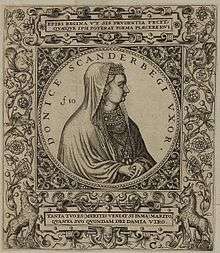Donika Kastrioti
Donika Kastrioti (née Andronika Arianiti-Muzaka)[a] was an Albanian noblewoman and the spouse of George Kastrioti Skanderbeg. She was the daughter of Gjergj Arianiti, one of the greatest leaders in the Albanian war against the Ottoman Empire for more than two decades.
Andronika (Donika) Kastrioti | |
|---|---|
 1596 engraving by Johann Theodor de Bry (1561–1623) | |
| Full name
Andronika (Donika) Arianiti Muzaka | |
| Born | 1428 Kaninë, Ottoman Empire |
| Died | Valencia, Kingdom of Valencia |
| Buried | Royal Monastery of the Holy Trinity (Valencia) |
| Noble family | Arianiti (paternally) Muzaka (maternally) Kastrioti (by marriage) |
| Spouse | Skanderbeg |
| Issue | |
| Father | Gjergj Arianiti |
| Mother | Maria Muzaka |
Life
Donika was born in Kaninë, in 1428. Her father, Gjergj Arianiti was a member of the Arianiti family whose domain stretched across the Shkumbin valley and the old Via Egnatia road and reached to the east today's Bitola. Her mother, Maria Muzaka was a member of the Muzaka family whose domain was the Myzeqe region.[1]
A month after the Treaty of Gaeta, on 21 April 1451, Skanderbeg married Donika, and thus strengthened the ties with the Arianiti family,[2] in the Eastern Orthodox Ardenica Monastery,[3][4] in Lushnje, present-day southwestern Albania. Later her sister Angelina married Serbian ruler Stefan Branković. She is venerated as a saint in the Serbian Orthodox Church.[5]
After the Ottoman conquest of Albania, the Kastriotis were given peerage in the Kingdom of Naples.[6] They obtained a feudal domain, the Duchy of San Pietro in Galatina and the County of Soleto (Province of Lecce, Italy).[7] Gjon Kastrioti II, Donika's and Skanderbeg's only child, married Irene Branković Palaiologina, the daughter of Lazar Branković, Despot of Serbia.[7]
Donika had a close friendship with the second wife of King Ferdinand I of Naples, Joanna of Aragon who is also the sister of Ferdinand of Aragon. After the beginning of the Italian War of 1494–1498, Donika was forced to leave Naples and arrived in Valencia around 1501 along with her grandchild, Alonso Kastrioti.[8] They found refuge in the royal palace.
Notes
- ^ Her name is mentioned as Andronica Comneniates in Gjon Muzaka's work about the Muzaka family.[9] Oliver Jens Schmitt names her Andronika Arianiti in his biographical work on Skanderbeg.[10]
References
- Anamali, Skënder (2002), Historia e popullit shqiptar në katër vëllime (in Albanian), I, Botimet Toena, pp. 255–257, OCLC 52411919
- Frashëri 2002, p. 181
- Elsie, Robert (2000). A dictionary of Albanian religion, mythology, and folk culture. New York University Press. p. 14. ISBN 0-8147-2214-8.
- Gjika, Ilirjan. "Manastiri i Ardenices" (in Albanian). Retrieved 28 July 2010.
- Elsie, Robert (2001). A dictionary of Albanian religion, mythology and folk culture. C. Hurst. p. 9. ISBN 978-1-85065-570-1. Retrieved 26 November 2010.
- Gibbon 1901, p. 467
- Runciman 1990, pp. 183–185
- The Untold Story: Skanderbeg’s Wife’s Life and Death in Exile on YouTube
- John Musachi: Brief Chronicle on the Descendants of our Musachi Dynasty Archived September 10, 2010, at the Wayback Machine
- Schmitt Oliver, Skanderbeg, Der neue Alexander auf dem Balkan, Verlag Friedrich Pustet, 2009, p. 45
![]()